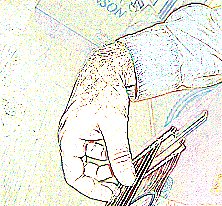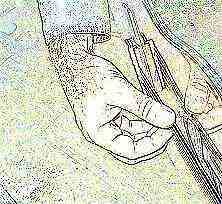When learning how to play classical guitar everybody spends a lot of time and focus on the left hand. It seems like a natural thing to do. You need to focus on the left hand - at first. And it is closer to your eyes so it is easier to stay focused on the that hand. But as you progress you really need to make a conscious effort to improve your right hand play.
The secret to really good classical guitar playing lies in the right hand. This is where you will get stunning music from. The right hand is the key to spectacular sound and lightning fast speed. The right hand is the hand that feels the music and it is from here that you will find expression.
 The first thing you should be aware of is general positioning of your hand and the angle of your wrist. This illustration shows poor wrist attitude. Make a conscious effort to have your wrist be less bent than this. The first illustration in this article shows better wrist angle.
The first thing you should be aware of is general positioning of your hand and the angle of your wrist. This illustration shows poor wrist attitude. Make a conscious effort to have your wrist be less bent than this. The first illustration in this article shows better wrist angle.
With your wrist bent like this your tendons and muscles are taut and you will not be able to achieve a relaxed and fast technique. This may seem like a more comfortable position at first but train yourself out of this and it will pay off in huge dividends in the future.
Practice your right hand technique
I recommend you make time in every practice session to do right hand oriented picking and strumming patterns. Make it a point to focus on your right hand and there are quite a few good reference, technique and instruction books that will help you with this. Typically you will get a series of picking patterns that you can practice over and over. With this practice you will muscles will learn the patterns and you will be able to do them without thinking about them. And as you get better you will get more and more complex patterns to practice.
Let's Talk a little bit about Right Hand Techniques
This is going to show you why the right hand is so very important to classical guitar playing. It is in this hand that playing the instrument goes from a mechanical thing to a living breathing expression of you.
Two Major Types of strokes
- The Rest-stroke ( is called apoyando ), - the finger that plucks the string rests on the next string afterwards; and
- The Free-stroke (is called tirando ), - the finger hits nothing after plucking the string. Some players, particularly if they have long nails sometimes use this stroke almost exclusively.
The free stroke is the more natural of the two strokes and if you are a self-taught guitarist it might be the only stroke you make. But the rest-stroke is an important part of the technique repertoire and you should practice it. Listen to the two strokes and get a feel for how they express the notes differently. Rest-strokes may be awkward for you at first but with practice you will improve and integrate into your box of playing tools.
Alternation of Fingers
This is a big part of playing and even the best players need to practice this on a regular basis. Rarely are any two notes in a row played with the same finger (with the exception of the thumb) .. You have to learn to alternate fingers cleanly and quickly and this skill is made even more difficult when you are moving across strings. And you need to practice it in a variety of different fingering patterns.
Walking the Strings - An Easy way to practice and improve
If you want to just cook up a way for your right hand play to improve you can easily make your own exercises to practice. Here is a suggestion for your own exercises and you can do this with all the strings open so you focus only on your right hand or you can practice it while doing scales.
Heres how to do it: Simply pluck down then up the six strings alternating between your index and middle fingers. Easy enough right? You started out with your index finger plucking the bass E string right? Now change that up and start your plucking by using your middle finger on the bass E string! Feels quite a bit different doesn't it? Now do a three finger pattern using index, middle and ring finger. And of course mix that pattern up by starting with a finger other than your index. This will probably feel a little awkward at first but keep at it. With a simple practice exercise like this your classical guitar playing will improve dramatically.
A free pdf of 120 studies for the Right hand on classical guitar
If you want to practice right hand techniques while you read music (two birds with one stone there) I have a free pdf you can download. It was created by Mauro Giuliani and it is pretty much a standard of any professional guitarists practice sessions. There are 120 exercises that progress in difficulty so as a beginner you can just slowly over time make your way further through the exercises.
The exercises use a pretty standard notation to show you which finger to use when plucking the strings.
- p = thumb
- i = index finger
- m = middle finger
- a = annular finger (ring finger)
This document is in the public domain so you are free to download it, print it and share it with your friends.
120 Studies for the right hand by Mauro Giuliani (2.4 meg pdf)
Another tip about notation
Matteo Carcassi of the famed Carcassi Method uses a different notation that you will sometimes see when hunting around for sheet music. It goes like this:
- X or + = thumb
- • = index finger
- •• = middle finger
- ••• = annular (ring finger)
If you are looking for a technique book that will really take your playing to new heights I strongly recommend the Scott Tennant book called Pumping Nylon. I own it and it has dramatically improved my playing. It has plenty of exercises and tips on right hand play but it is an overall technique book that has left hand play and a lot of other things that will take your overall playing ability to new heights.











No comments:
Post a Comment